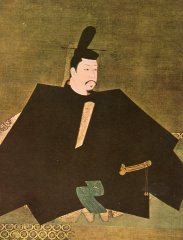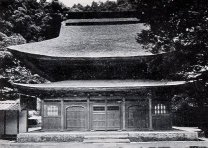
Kamakura Era: 1192-1333
This was the period of time marked by the beginning of the era of the shoguns. This started with the fall of the Heike house. Minamoto-no-Yoritomo was the leader of the house Genji and basically was in competition with the Emperor for control of Japan. The Emperor assigned him Seii-tai-shogun, a post he created for commanding military armies to defeat barbarians. The catch was that the shogun could move those armies without the Emperor's permission, thus making the shogun the true ruling power in the country.

Portrait of Yoritomo
Minamoto-no-Yoritomo established his own military government at Kamakura. This began a 700 year rule by various shoguns.
The house Genji was not a lucky one, though, as Minamoto-no-Yoritomo died soon after starting the Kamakura shogunate. His sons died soon too and the house ended with the assassination of the third shogun, Minamoto-no-Sanetomo, in 1219.
Emperor Gotoba in Kyoto wanted to take back control of the country and raised his own army. The widow of Yoritomo, though, made an appeal to bushi throughout the country and more of them flocked to her side. That army then marched to Kyoto and defeated the Emperor's army.
One of the more significant events was the accession to the throne of Go-Daigo in 1318. From the start, he made it clear that he was not going to abdicate the throne to anyone for any reason, and he intended to govern as long as he possibly could. He also began to conspire to overthrow the military control of the country. Before he could put his plans into action, he was betrayed by one of his advisers.
The Bakufu replied by sending officers to Kyoto to arrest leading supporters of Go-Daigo. Full military response to Go-Daigo began, and in 1331 he was in the palace surrounded by the Bakufu military force. He fled the palace and ended up going to the monastery at Kizugawa, a monastery filled with soldier-monks.
The Bakufu found out and attacked and overwhelmed the monks, with Go-Daigo escaping but taken captive later. He and some of his followers were banished in 1332 to the island of Oki.
This did not totally end the opposition to the Bakufu, though, and further fighting took place with Bakufu troops entering the capital and attacking the loyalist army in the south, with the Bakufu troops basically having success after success in their campaign.
Fortunately not everything during this period was based on violence. Agricultural process was made through the use of draught animals and semiannual crops. The Jodoshin sect of Buddhism developed during this time.
It was also during this time that the ritual form of suicide known as seppuku was invented.
During this time clothing became simpler in nature. Trousers called hakama were worn by women of the ruling military class and women of the court. The Kasuga Gongenreigenki emaki is a hand-painted scroll from about 1309 and shows women of the upper classes wearing patterned kimonos. It is considered that all fields of culture suffered a decline during this period of time.
Even the architecture of this period became simpler. Many Zen temples were built during this time. Painted portraits also appeared during this time.

The Shariden, or Relic Hall, the only building in Kamakura left from the Kamakura period.
The Engaku-ji temple (of which the Relic Hall above is a part) was established in 1282 by Hojo Tokimune. A Chinese monk was invited to Japan to head up the new temple. All of the other buildings of the temple have since been destroyed.
Particular dates of importance
1198-1210: Emperor Tsuchimikado
1105: Shin Kokin-wakashu, a poetry anthology, is published
1210-1221: Emperor Juntoku
1219: Sogun Minamoto no Sanetomo is assassinated. Hojo then dominates the shogunate.
1221: Emperor Chukyo
1221: Third battle of Uji. Hojo army enters Kyoto, defeating troops of Go-Toba.
1221-1232: Emperor Goshirakawa
1224: Jodo Shin (New Jodo) sect of Buddhism established by Shinran.
1227: The potter Toshiro, who traveled for four years in China, returns to Japan and starts the porcelain manufacture industry.
1227: Soto sect of Buddhism is introduced.
1232: Samurai legal code issued
1232-1242: Emperor Shijo
1242-1246: Emperor Go-Saga
1246-1260: Emperor Go-Fukakusa
1253: Nichiren sect of Buddhism established
1260-1274: Emperor Kameyama
1274: Mongol army attacks northern Kyushu, is repulsed by a typhoon.
1274-1287: Emperor Go-Uda
1274: Mongols make their first attempt to invade Japan.
1281: Destruction of the Mongol fleet by a typhoon ("divine wind",also called kamikaze) ends the second Mongol invasion attempt. In this attack there were about 50,000 Mongols and Koreans and 100,000 Chinese (China had been conquered by the Mongols). The attacking armies suffered around an 80% casualty rate. This ended all attempts at invading Japan for hundreds of years.
1287-1298: Emperor Fushimi
1298-1301: Emperor Go-Fushimi
1301-1308: Emperor Go-Nijo
1308-1318: Emperor Hanazono
1318-1368: Emperor Go-Daigo
1324: Failure of Go-Daigo's first plot against the Bakufu
1331: Siege of Kasagi fortress, with Go-Daigo's forces losing.
1331: Siege of Akasaka fortress, another Go-Daigo loss.
1331: Failure of Go-Daigo's second plot against the Bakufu
1331: Emperor Godaigo rebels against the Kamakura shoguns resulting in the establishment of rival courts at both Kyoto and Nara.
1331-1333: Northern Court Emperor Kogon
1333: The siege of Kamakura

South portal of the Todaiji temple at Nara, built in 1199.
|